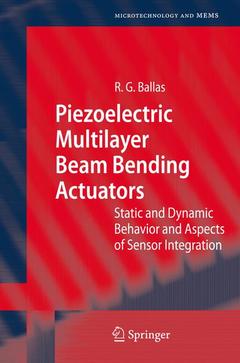Description
Piezoelectric Multilayer Beam Bending Actuators, 2007
Static and Dynamic Behavior and Aspects of Sensor Integration
Microtechnology and MEMS Series
Author: Ballas Rüdiger G.
Language: English
Subject for Piezoelectric Multilayer Beam Bending Actuators:
358 p. · 15.5x23.5 cm · Hardback
Description
/li>Contents
/li>Biography
/li>Comment
/li>
An important aim of the presented book is the explanation of the application of piezoelectric materials such as piezoceramics within the wide field of electromechanical actuators and sensor technology. The reader should be presented the physical and mechanical properties of piezoceramics in a distinct way. In a next step, the reader is introduced into the mechanical description of the static behavior of piezoelectric multilayer beam bending actuators.
The description of the dynamic behavior of piezoelectric multilayered bending actuators is effected on the basis of Lagrange?s formalism and Hamilton?s principle. The achieved insights are used for the systematic development of the electromechanical circuit representation within the scope of the network theory for any design of piezoelectric bending actuators.
The applications of piezoelectric multilayer beam bending actuators can be extended by means of special displacement sensors allowing for the compensation of effects such as hysteresis, creep and drift being typical for piezoelectric actuators. Within the scope of the presented book, two different sensor-actuator-systems are presented being based on an integrated capacitive and inductive displacement sensor, respectively.
Analytical simulations of the static and dynamic behavior are compared to real measurement results of a specially developed piezoelectric multilayer beam bender. Here, the suitability of the developed theoretical aspects is shown in an outstanding way.
Rüdiger G. Ballas was born in 1971 in Blieskastel, Germany. After finishing education as an assistant in physics at the Technical School for Natural Sciences Ludwigshafen, Germany, he received the diploma in microsystemtechnology in 1999 from the University of Applied Sciences Kaiserslautern, Germany. From 1999 until 2001 he worked with Tele Quarz in Neckarbischofsheim, Germany, where he was head of the group concerning microstructuring of AT-quartz crystals and development of high-frequency inverted MESA-quartzes. From 2001 until 2006 he worked as a Ph.D. student at Darmstadt University of Technology in the field of piezoelectric bending multilayer actuators with integrated sensors for tip deflection measurements. He received the Ph.D. degree in electrical engineering in 2006 from Darmstadt University of Technology. His actual research fields are theoretical mechanics, electromechanical system theory and modeling of the nonlinear behavior of piezoelectric actuators.




